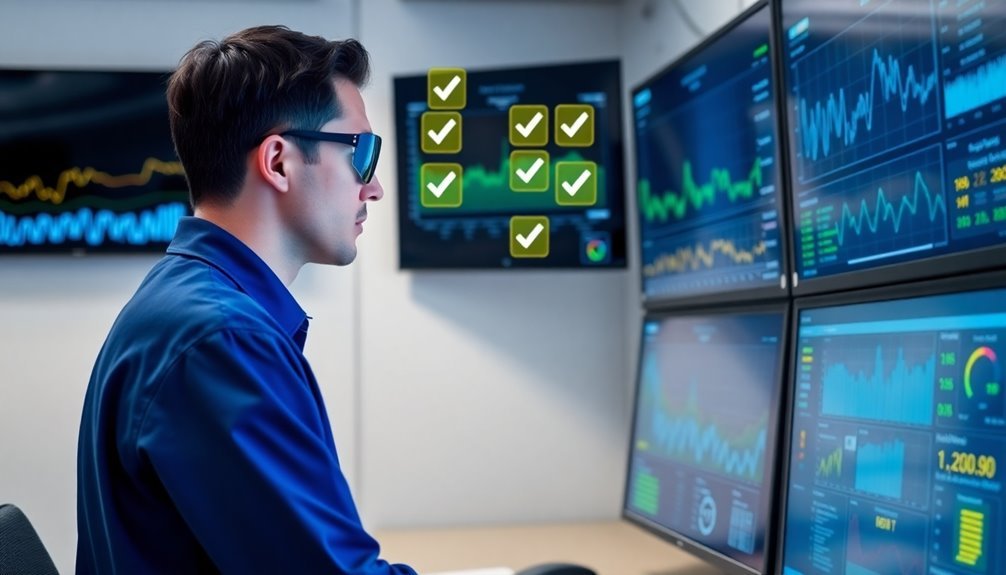To validate your monitoring systems effectively, you'll need to follow these seven essential steps: First, establish clear system requirements with measurable outcomes. Next, document all installation parameters and configurations thoroughly. Then, test your operational functions to verify core controls and alerts. Fourth, verify performance standards against established benchmarks. Fifth, implement robust data security measures including encryption and access controls. Sixth, record detailed system validation results in a traceable format. Finally, maintain continuous system assessment protocols. Following these validation steps will reveal deeper insights into optimizing your monitoring infrastructure.
Establish System Requirements

Establishing clear system requirements forms the foundation of any effective monitoring system validation. You'll need to define both system and stakeholder requirements in quantifiable, measurable terms to guarantee accurate validation processes. By eliminating ambiguity from your requirements, you're setting up a framework that enables precise comparison between system performance and expected outcomes. The process requires continuous assessment throughout development to prevent costly late-stage adjustments.
You must identify the validation scope and constraints that will impact your monitoring system. Consider technical limitations, budget restrictions, time constraints, and contractual obligations when planning your validation actions. You'll want to strike a balance between what should be validated and what can be objectively measured within your constraints.
Your validation strategy should include specific techniques like inspection, analysis, simulation, review, and testing. Make sure you've identified all necessary tools, personnel, and facilities needed to execute these validation actions.
You'll need to detail expected results for each validation step and define the configuration of elements being tested.
Finally, plan how you'll execute validation actions and document results. You should create a system for capturing, analyzing, and reporting findings, including any issues or change requests that arise during validation.
Document Installation Parameters
A well-documented monitoring system starts with proper installation parameter documentation. You'll need to meticulously record all configuration settings, including default values and any customized parameters you've implemented. By maintaining clear documentation of your monitoring parameters, you're guaranteeing system reliability and making future troubleshooting much easier.
When documenting installation parameters, focus on these significant aspects:
- Parameter Configuration Details: Record all default values, modified settings, and custom monitoring parameters you've created. Make sure to document the rationale behind any changes from default settings. The system allows for pre-evaluated default values that can be easily accessed through the user interface.
- Essential Parameter Specifications: Define and document acceptable ranges for vital parameters like temperature, pressure, or other process-specific measurements. Include control limits and monitoring methods you're using.
- Change Management Protocol: Implement a robust system for tracking modifications to parameter settings. You should maintain version control and create detailed audit trails for all configuration changes.
To maintain effective documentation, you'll need to regularly update your records and make certain they're easily accessible to authorized personnel.
Remember to implement proper access controls and keep your documentation clear and concise, focusing on essential information that impacts system performance and validation.
Test Operational Functions

Testing operational functions requires you to verify core system controls through thorough validation of command sequences, alerts, and response mechanisms.
You'll need to actively monitor critical data points to guarantee accurate readings, proper threshold detection, and timely notification systems are functioning as intended.
The process helps assess system design requirements to ensure long-term operational readiness and compliance with specifications.
Verify Core System Controls
Verifying core system controls requires an all-encompassing approach that combines automated testing with operational validation.
You'll need to implement thorough testing mechanisms that evaluate control objectives in a pass/fail format while guaranteeing continuous monitoring of system functionality. Through automated micro-certifications and real-time monitoring, you can quickly identify anomalies and respond to potential issues before they impact operations. CCM supports this by enabling data-backed decisions through comprehensive risk assessment and monitoring capabilities.
Your verification process should focus on three critical areas:
- Automated Testing Integration – Set up hourly tests that connect with device management platforms, enabling secure configuration changes and maintaining consistent security posture checks.
- Access Management Validation – Deploy immediate access reviews through micro-certifications to catch unauthorized changes and policy violations, particularly for privileged access and segregation of duties.
- Functional Monitoring Implementation – Establish real-time monitoring systems that assess system availability, track use cases, and notify stakeholders of any malfunctions through automated alerts.
Remember to validate both operational readiness and system behavior throughout the SDLC phases.
You'll want to guarantee your monitoring systems can effectively track response times, overall speed, and other non-functional requirements while maintaining continuous compliance with established controls.
Monitor Critical Data Points
Monitoring critical data points demands a structured approach to tracking system performance and operational health. You'll need to identify key metrics like CPU usage, memory utilization, and network latency while establishing clear thresholds that trigger alerts when systems deviate from acceptable ranges. The implementation of real-time data analysis enables faster and more informed decision-making processes.
Set up your monitoring intervals strategically by implementing both scheduled and continuous monitoring protocols. You'll want to customize these intervals based on your system's specific requirements and integrate them seamlessly with existing applications. Consider using both push and pull models to guarantee thorough data collection across your infrastructure.
Establish robust communication protocols by configuring alerts through multiple channels like email, SMS, and push notifications. You should visualize your data through dashboards and generate regular reports that highlight key performance indicators.
Don't forget to implement secure data transmission methods to protect your monitoring infrastructure.
Finally, validate your collected data through rigorous integrity checks and analysis. You'll need to implement proper cybersecurity measures, including encryption and firewalls, while guaranteeing efficient data filtering and aggregation.
Remember to maintain compliance with relevant regulatory standards through appropriate documentation and reporting procedures.
Verify Performance Standards
Performance standards serve as the foundation for any effective monitoring system. To verify these standards effectively, you'll need to establish clear metrics, develop appropriate monitoring tools, and consistently evaluate performance data against your predetermined benchmarks.
When you're setting up your verification process, focus on creating quantifiable measures that accurately reflect your system's performance requirements. Make sure to maintain parallel phrasing throughout your documentation to ensure clarity and consistency.
- Start by defining specific performance indicators and thresholds that align with your operational goals. You'll want to establish both minimum and maximum acceptable ranges for each metric you're monitoring.
- Implement systematic comparison tools that can effectively measure performance against your established standards. You'll need to guarantee these tools provide accurate, reliable data while remaining cost-effective for your organization.
- Regularly analyze the collected data to identify patterns and potential areas for improvement. Don't forget to document your findings and make necessary adjustments to your standards as your system evolves.
Remember to maintain a continuous review cycle of your performance standards. You should periodically assess whether your monitoring system is still accurately measuring what's important and make refinements as needed to guarantee ongoing effectiveness.
Implement Data Security Measures

You'll need to establish robust access control management by implementing role-based permissions and regularly reviewing user access rights to prevent unauthorized data exposure.
Organizations should employ Security Information Management systems for centralized monitoring and threat detection capabilities.
Your encryption protocol standards must meet industry requirements, incorporating both data-at-rest and data-in-transit protection using current encryption algorithms.
Access Control Management
A robust access control management system serves as the cornerstone of data security in any monitoring environment. You'll need to establish thorough policies that govern how users interact with sensitive data while implementing multi-layered security measures.
By customizing permissions based on user roles and maintaining detailed audit trails, you're creating a secure framework that protects your critical information. This approach enables organizations to meet data privacy regulations and avoid potential compliance penalties.
To strengthen your access control system, focus on these essential components:
- Implement multi-factor authentication combining passwords, biometric solutions, and secure tokens to verify user identities before granting access to sensitive data.
- Deploy real-time monitoring tools that track user activities, generate audit logs, and alert you to suspicious behavior patterns or potential security breaches.
- Establish regular security audits and employee training programs to identify vulnerabilities and guarantee your team stays current with the latest security protocols.
Remember to classify your data based on sensitivity levels and apply appropriate protection measures, including data masking and encryption.
You should also integrate physical access controls, such as ID badges and biometric devices, to maintain a complete security perimeter that protects both digital and physical assets.
Encryption Protocol Standards
Building upon your access control framework, strong encryption protocols form the backbone of your data security strategy.
You'll need to implement both symmetric and asymmetric encryption methods, using industry-standard protocols like AES-256 and RSA to protect sensitive data both at rest and in transit.
Start by classifying your data based on sensitivity levels to determine appropriate encryption requirements. You'll want to encrypt critical data using AES with at least 256-bit keys for storage, while implementing TLS for data transmission.
For highly sensitive information like passwords and PINs, consider using Triple DES as an additional security layer.
Ensure your encryption implementation aligns with GDPR requirements and industry standards. You'll need to establish clear security policies that outline encryption procedures, key management, and access controls.
Don't encrypt everything – implement granular controls to selectively encrypt sensitive data while maintaining system performance.
Monitor your encryption systems continuously through automated tools and regular audits. This helps you detect potential security incidents and maintain compliance with regulatory requirements.
Remember that proper encryption not only protects your data but also provides regulatory benefits and can minimize potential fines in case of breaches.
Record System Validation Results
Recording system validation results requires a systematic approach that combines thorough documentation with careful attention to detail.
You'll need to follow your validation plan while using proper documentation tools and templates to guarantee consistency throughout the process. As you execute validation procedures, it's essential to maintain a detailed validation traceability matrix that tracks all actions, techniques, and results.
During the validation process, you'll want to focus on these key elements:
- Data Integrity – Capture and record results meticulously using predefined templates, validating all information is accurate and properly stored in secure systems that allow easy retrieval.
- Issue Management – Document any non-conformities or problems encountered, creating detailed trouble reports and managing change requests as needed.
- Compliance Documentation – Generate validation reports and summaries that meet regulatory requirements while maintaining proper audit trails.
Remember to analyze all results thoroughly to confirm they meet specified requirements.
You should store all validation data securely while maintaining clear audit trails of activities and modifications.
Once completed, issue system certification only after confirming that all acceptance criteria have been satisfied and documentation controls are in place.
Maintain Continuous System Assessment

Continuous system assessment's success relies on implementing a structured framework of regular evaluations and feedback mechanisms. You'll need to establish systematic approaches that incorporate planned evaluations while maintaining consistent criteria throughout the monitoring process.
To effectively maintain continuous assessment, you should implement various evaluation types. Start with formative assessments that provide immediate feedback, use diagnostic assessments to gauge baseline performance, and conduct regular summative assessments to evaluate overall system effectiveness.
You'll find that peer assessments and holistic evaluations add valuable perspectives to your monitoring framework.
Integrate your assessment strategies into daily operations by leveraging technology and automated tools. You can use Learning Management Systems to streamline the evaluation process, reducing your workload while maintaining assessment quality.
Make sure you're providing immediate feedback through automated quizzes and regular check-ins to identify potential issues quickly.
The benefits you'll gain include timely intervention opportunities, diverse evaluation methods, and enhanced engagement from all stakeholders.
Frequently Asked Questions
How Often Should Validation Team Members Undergo Training and Certification Updates?
You should update your validation training annually through VTI certification courses, with additional quarterly continuing education sessions. Don't forget to complete self-paced modules whenever there are significant regulatory changes or updates.
What Are the Cost Implications of Failing a System Validation Audit?
You'll face severe financial consequences, including hefty regulatory fines, increased remediation costs, potential legal penalties, damaged reputation, and lost business opportunities. The cost of failing an audit far exceeds proper validation investments.
Can Legacy Systems Be Validated Using the Same Protocols as New Installations?
You can validate legacy systems using standard protocols, but you'll need to adapt them to account for missing documentation, historical data, and existing risk controls that weren't formally documented during initial implementation.
How Do Environmental Factors Affect the Validation Process and Timeline?
You'll find that environmental factors impact your validation through equipment accuracy, calibration needs, and maintenance timing. Temperature, humidity, and air pressure variations can extend your timeline and require additional validation steps.
What Contingency Plans Should Be in Place During System Validation Failures?
You'll need to immediately notify IT teams, activate backup systems, restore data from offsite backups, run concurrent processing, and perform validation testing. Keep stakeholders informed throughout the recovery process.
In Summary
You've now got the essential framework to properly validate your monitoring systems. By following these seven critical steps, you'll confirm your system meets requirements, functions correctly, and maintains data integrity. Don't skip any steps in the validation process – each one builds upon the last. Remember to document everything and keep up with regular assessments to assure your system's continued reliability and effectiveness.





Leave a Reply